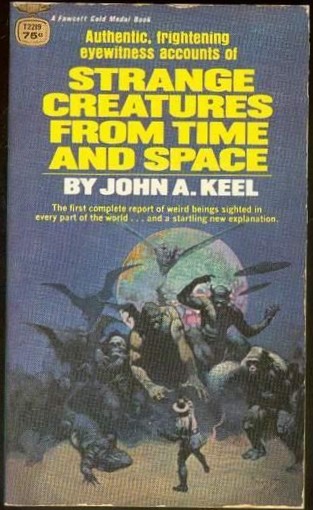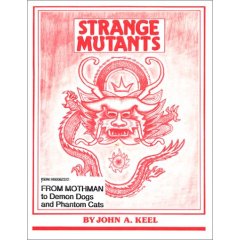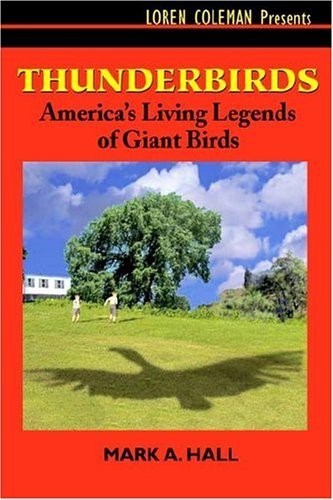
May 13, 2008

Okay, the news organizations’ election primary attention shifts to West Virginia today, Tuesday, May 13th, so let’s talk Mothman.
Actually, I’m going to use this opportunity to note the sinister editing that regularly takes place at the Wikipedia entry for “Mothman.”
I’ve been watching the site because some incredible “political” inputs have occurred with the “Mothman” entry, apparently by skeptics and debunkers inserting words like “claims” and deleting large sections of information.
I did not write any of the section, but have dipped in to correct citations, edit slanted words out, and to try to remove mistakes. But what I recently did was merely go look and copy the paragraph that was written about me (where I should know if the facts were off), to see how the “editors” were changing passages.

A month ago, the “Mothman” entry, under “Analysis,” contained this:
“Cryptozoologist Loren Coleman, in conjunction with Sony/Screen Gems studio and as noted in the documentary film by David Grabias, In Search of the Mothman, served as one of the fictional movie’s two publicity spokespersons (Keel being the other, although Keel’s involvement was limited by health concerns). Coleman also appeared on 300 radio and television interview programs discussing the nonfiction version of the Mothman story, which he documents in Mothman and Other Curious Encounters (ISBN 1-931044-34-1). After the movie’s release, Coleman created a research tool, the ‘Mothman Death List,’ whereby various eyewitnesses, movie personnel, and researchers are noted who appear to suffer early or unusual deaths, [3] adding to the list from 2002 through April 2007. [4] Coleman documents in his books, lectures, and articles in Fortean Times, that early eyewitnesses never described a man, but a large bird. Coleman, who has a post-graduate degree in psychiatric social work, has researched the psychological outcomes of why the descriptions have changed due to media influence and the ‘fear factor’ created by other writers. Witnesses such as Faye DeWitt, Marcella Bennett, and Linda Scarberry have repeatedly stated on national TV that the Mothman was half human, although their earlier accountings noted the birdlike qualities of their sightings. Coleman and Mark A. Hall discovered examples of Thunderbird-like birds were seen in WV 100 years ago, which were cited, footnoted, and referenced in Mark A. Hall’s Thunderbirds (to which Coleman wrote an introduction).”
The numbers “3” and “4” were tied to citations for what was written, of course. But someone has gone in, deleted most of this paragraph, including the citations, and what remains is this:
“Cryptozoologist Loren Coleman, in conjunction with Sony/Screen Gems studio and as noted in the documentary film by David Grabias, ‘In Search of the Mothman,’ served as one of the fictional movie’s two publicity spokespersons (Keel being the other, although Keel’s involvement was limited by health concerns).[citation needed]”
Citation needed? That’s it. No citations, especially after all of them were stripped away. Trimmed down. That is all that remains of what was there a month ago.
I was going to entitle this blog, “More Reasons Why I Hate Wikipedia,” but that’s perhaps too harsh.
As to my theory that the posting is constantly being edited by a skeptic, I note whomever the “expert” who keeps revising this “Mothman” Wikipedia entry is, he or she is not a Mothman scholar, that’s for sure.
This anonymous person rounds out the “Analysis” section with this “observation”:
“…a simple analysis of Keel’s earliest Mothman book, ‘Strange Mutants: Demon Dogs and Phantom Cats’ [sic] (1970) shows almost no difference with what Keel wrote in ‘The Mothman Prophecies’ five years later.”

Of course, the book published in 1970 was Strange Creatures From Time and Space (Greenwich, CT: Fawcett), which was based on material Keel had previously published in “West Virginia’s Enigmatic ‘Bird’,” Flying Saucer Review, 14, 4, July/August 1968, pp. 7-14, and “Mothman Monster,” Saga, 37, 1, October 1968, pp. 66-70.
The book Wikipedia mentions with the incorrect title is actually Strange Mutants: From Mothman to Demon Dogs and Phantom Cats. First published by Inner Light-Global Communications, on April 15, 1982, Strange Mutants is a slightly condensed version of the earlier (1970) out of print Strange Creatures From Time and Space. (Despite the cheap printing, copies of this book sell for nearly $200 these days.)

For Wikipedia to call Strange Mutants “Keel’s earliest Mothman book” is wrong on many levels. The actual book they are trying to discuss is 1970’s Strange Creatures From Time and Space and is only partially about Mothman, having reprinted Keel’s 1968 Mothman-specific magazine pieces in a chapter and an appendix.
To say that there is “no difference” between what Keel wrote in Strange Creatures From Time and Space and The Mothman Prophecies: An Investigation Into the Mysterious American Visits of the Infamous Feathery Garunda (New York: Saturday Review Press/E. P. Dutton, 1975) is like saying there is “no difference” between a brief Jeff Meldrum interview in a Bigfoot TV documentary and Meldrum’s recent entire book on the subject of Sasquatch. One is a treatment slightly reflective of the larger phenomena, and the other is a chronicle of an individual’s thoughtful examination of the broader context of cryptic sightings and related events.
But then, in the realm of cryptozoology, Wikipedia often gets it incredibly spot-on or terribly off-base.
So, if you are tempted to read about West Virginia’s most famous weird cryptid on this primary election day, make certain you look beyond the Mothman Wikipedia entry.

For a more definitive, calmer view of Mothman, read a “just the facts” approach to them in Mark A. Hall’s Thunderbirds.
About Loren Coleman
Loren Coleman is one of the world’s leading cryptozoologists, some say “the” leading living cryptozoologist. Certainly, he is acknowledged as the current living American researcher and writer who has most popularized cryptozoology in the late 20th and early 21st centuries.
Starting his fieldwork and investigations in 1960, after traveling and trekking extensively in pursuit of cryptozoological mysteries, Coleman began writing to share his experiences in 1969. An honorary member of Ivan T. Sanderson’s Society for the Investigation of the Unexplained in the 1970s, Coleman has been bestowed with similar honorary memberships of the North Idaho College Cryptozoology Club in 1983, and in subsequent years, that of the British Columbia Scientific Cryptozoology Club, CryptoSafari International, and other international organizations. He was also a Life Member and Benefactor of the International Society of Cryptozoology (now-defunct).
Loren Coleman’s daily blog, as a member of the Cryptomundo Team, served as an ongoing avenue of communication for the ever-growing body of cryptozoo news from 2005 through 2013. He returned as an infrequent contributor beginning Halloween week of 2015.
Coleman is the founder in 2003, and current director of the International Cryptozoology Museum in Portland, Maine.
Filed under Breaking News, Cinema News, Conspiracies, Cryptomundo Exclusive, Cryptotourism, CryptoZoo News, Cryptozoologists, Cryptozoology, Men in Cryptozoology, Mothman, Movie Monsters, Pop Culture, Reviews